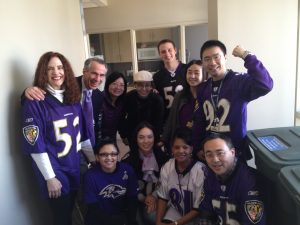If you listen closely, you’ll hear the buzz begin sometime in August. With your eyes, you’ll start to see the signs in early September. As the week comes to a close, like clockwork, the office environment becomes unmistakably … monochromatic. You may not notice it at first, but once you start to pay attention, it’s impossible to miss. Each and every Friday in the autumn and winter, the city of Baltimore turns overwhelmingly purple. And then the color builds all weekend long, reaching a mighty crescendo on Sunday afternoon.
 When spring rolls around, the palette changes, and the colors no longer wax and wane with the days of the week. As the days lengthen and the weather warms, the crowds trade purple for orange, and if you look around, you’ll see folks in orange every day in Baltimore, all summer long.
When spring rolls around, the palette changes, and the colors no longer wax and wane with the days of the week. As the days lengthen and the weather warms, the crowds trade purple for orange, and if you look around, you’ll see folks in orange every day in Baltimore, all summer long.
Purple is the primary team color for the Ravens, the Baltimore NFL football team. The city’s MLB team, the Orioles, dresses in orange. The camaraderie derived from sports in Baltimore is pervasive, and the fever is infectious. Sometimes the enjoyment comes from the games themselves, but just as often — and much more importantly, I would argue — it comes from the connections they enable us to create with everyone around us. After all, so much of who we are is defined by how we interact with the people we see every day.
Just by paying a little attention to Baltimore sports, I feel like I have something in common with everyone in the city. Every morning, I talk about baseball or football with the MTA employees who work at the Metro station near my apartment building. Every evening when I get home, I ask the security guard at the front desk which basketball game he’s looking forward to watching when his shift ends. In between, I talk sports with my lab mates, with people delivering packages, with the grad students and faculty members in labs down the hall.
I admit that in many ways, these conversations are trivial. And with the increasingly disturbing connections between professional sports and brain trauma and domestic violence, I understand completely why some people find the games hard to watch. Still, I treasure the many relationships in my life that have a basis in sports. Even the strongest interpersonal connections are ultimately built on the little things people experience together day in and day out, and these little things create a shared backdrop for the more substantial moments.
The custodial worker who picks up the trash in my lab might be the biggest sports fan I know. He has an amazing memory for numbers; off the top of his head, he seems to know the age, contract status and salary of every player in the NFL. He is also an African-American man working a blue-collar job in Baltimore City; although we cross paths almost every day, in many important ways, he and I live in very different worlds. Last year, when Freddie Gray died, we talked for a long time about this city, about history, about pain, about the future. Notwithstanding all of the seminars, lab meetings and data reviews, this was the most important conversation I had in five years of graduate school.
And at the end of the day, this conversation was possible because of the hundreds of smaller, simpler, easier conversations that preceded it, about free agents and draft picks and fourth-quarter comebacks. I really am a big fan of the games themselves, but when push comes to shove, this is why I watch.
Related Content
- #TimeForBaltimore: Hearts and Soles
Art director Abby Ferretti connects with her Baltimore city neighbors through exercise. Watch our video to learn more. - Visit the About Baltimore section to learn more about Charm City and its surrounding areas.